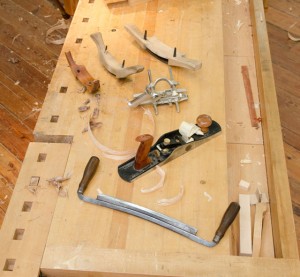 Setting up your woodworking shop can be a daunting task at first, with advertising ploys coming at you from every direction. If you have been to even one woodworking store and signed up for their e-mail newsletter, the next thing you know, your inbox is filled with advertisements for every imaginable gizmo and gadget, along with promises to make you a better woodworker! Or maybe you have come away from another woodworking show with more wonderful jigs and tools . . . . The question is what do you REALLY need to get started?
Setting up your woodworking shop can be a daunting task at first, with advertising ploys coming at you from every direction. If you have been to even one woodworking store and signed up for their e-mail newsletter, the next thing you know, your inbox is filled with advertisements for every imaginable gizmo and gadget, along with promises to make you a better woodworker! Or maybe you have come away from another woodworking show with more wonderful jigs and tools . . . . The question is what do you REALLY need to get started?
The answer depends on many variables. First consider how much space you have, then consider your budget, what you are planning to build and how much time you have to devote to your craft. I will assume that you have limited space and that you will mainly be using hand tools with a few selected machines. What I write here may not directly apply to your particular situation, but I hope you can glean some useful information from it.
The first and most important thing to have in your shop is a sturdy bench with at least one solid vise and a surface that does not shake or move when you work on it. Although a tail vise is not a must, it is very handy because it enables you to clamp your work on the face of the bench. I could write a whole article on the subject of workbenches alone, but as the old adage goes, you get what you pay for. Don’t skimp on your workbench, whether you build it or buy it. You want a heavy bench—one that would take you and all your neighbors to move; and you want a heavy top that will not vibrate when you chop mortises and dovetails. On the other hand, don’t let the lack of a good bench hold you back. Many fine pieces have been made on something as simple as a bench built from dimensional lumber from the home improvement center and joined together with good joinery. That’s what I use in my home shop—it is not pretty, but it is very functional.
After you get a good bench, I recommend starting with several hand tools. Spend as much as you can afford, but don’t let cost stop you from buying something to get started. You can learn to do beautiful work with very inexpensive tools. If you have the means to invest in high-quality new tools, you won’t need to spend as much time fixing up old tools. On the other hand, if you are willing to spend some time fixing up used tools, you can save a considerable amount of money, and you’ll be amazed at what you can find at antique stores, flea markets and even on Craigslist.
Here is a list of tools that should set you well on your way:
- A set of sharpening stones and a strop—You’ll use these to sharpen all your edge tools to a razor edge. $50-155
- An accurate combination square—Don’t buy a cheap combination square at the hardware store, as they tend to not be very accurate. Since accuracy is essential in woodworking, I recommend the Starrett, which is accurate and built to last a lifetime. $75
- A set of chisels—1/4″, 3/8″, 1/2″, 3/4″ and 1″ will do to begin with and will handle any kind of joinery including mortise cutting. You can get a good set of chisels for $70-275.
- A strong layout knife—A chip-carving knife is adequate to begin with, although I prefer to use a marking knife that we make here at the school. $20-65
- A combination marking/mortise gauge—You’ll use this in laying out nearly all your joinery. $37-60
- A small saw (dovetail or gent’s saw)—I recommend the Lie-Nielsen thin plate. You’ll use this for cutting dovetails and doing other fine work. $25-125
- A tenon saw—You’ll use your tenon saw a lot when doing hand-joinery, so I recommend getting a well-made saw. Working with a sharp saw makes a huge difference. Although many saws don’t come from the factory sharp, they can be sharpened easily with a few simple tools. (We teach how to do that in our one-day sharpening class and our new online course at HeritageWoodSchool.com.) $85-170
- A panel saw—Often you can find these at antique stores. Look for Disston, if getting a used one. $10-220
- A small hammer for joint assembly—I recommend a 10 oz. Warrington-style hammer. It has a flat head that doesn’t mar your work easily and is just the right weight. $10-25
- A solid joiner’s mallet—At our shop, we make high-quality joiner’s mallets by hand. These are quite a bit larger and heavier than the carver’s mallets that are commonly available, and they are much more effective for joinery work. $45
-
A #4 or #4 1⁄2 smoothing plane—The smoothing plane is the first plane that I recommend and is one of the most used planes in my shop. I use it for smoothing the surfaces of the wood after it has come out of the planer. I also use it to shape wood. I recommend the Lie-Nielsen, or you can find a used Stanley on eBay. $75-325
- A low angle block plane with an adjustable mouth—This plane is very handy for trimming end grain and easing the edges of your work. The adjustable mouth enables you to do very fine work. I recommend the Lie-Nielsen. $165
- A Stanley #5—for roughing stock down. $25-275
- A jointer plane either #7 or #8—Make sure that you get one that is flat. I recommend the Lie-Nielsen because it’s the only one that I know that is perfectly flat; or you can buy a used plane and flatten it. You’ll need this for getting edges perfectly flat and square in order to join larger pieces like table tops and dresser sides. $80-475
- A brace—these are a “dime a dozen” on the used market. $20-100
- A set of bits for the brace—I prefer the Russell Jennings. $40-100
- A router plane such as the Stanley #71—Although you can do a lot of joinery without the router, it is really handy for cleaning out the bottom of dados. A smaller version of the traditional router plane can be used for small dados and inlay work. $55-80
- A flat-bottomed spokeshave—You’ll use the spokeshave for shaping curves and spokes on different furniture elements. You can also use it for other types of carving, including spoon-carving. The old Stanley #151 is great. $28-97
- A card scraper—I use this tool for all my finish work. You can smooth wiry grain and figured woods. This tool is quite inexpensive but invaluable in the shop. I recommend either the Lie-Nielsen or the Bahco. $10-15
- A Stanley #80 cabinet scraper—This tool works wonders when smoothing out a glued-up tabletop where you have differing grain direction. You can also use it to smooth wild grain where a plane just will not work. The only good ones are the old used ones. $25-55
- A burnisher—for sharpening scrapers. $21-45
The simple list of hand tools above is a good place to start; then as you progress you will find you need more tools for specific projects. Some of those could include a plow plane, a low angle jack plane, a travisher and a drawknife.
- Travisher
- Low Angle Jack Plane
- Drawknife
As I mentioned before, buy the best tools you can afford, but don’t let the high prices of the best tools hold you back. I have purchased most of my personal tools in used condition from antique stores and estate sales. Even though I think there are some very fine tool makers now, every time I pick up one of my old tools with its rich patina and the well-worn feel of the handle, I feel a sense of connection to the craftsmen of old. It makes me aspire to do my best to carry on the craft.
Remember, if you are using only hand tools, you can turn a spare bedroom in the house into a workshop. Working with hand tools is quiet and doesn’t require much space. When you work with hand tools you don’t make much dust, just shavings!
Here’s a list of good tool suppliers.
The above was originally published as “Setting up Shop” in the SustainLife Journal. Check back soon for Frank’s take on woodworking machinery. Learn how to use your new (or old!) woodworking tools here on SustainLife.org.
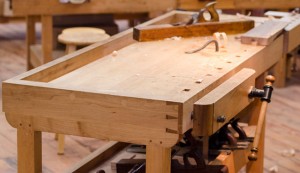
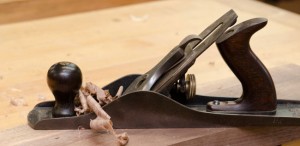
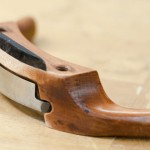
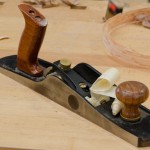
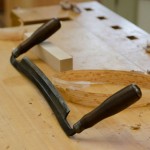
Comments are closed.